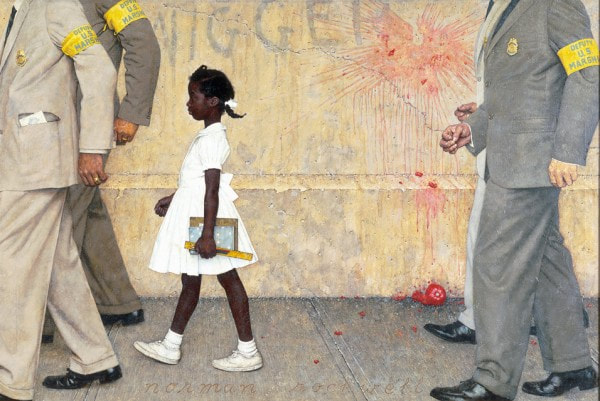|
VIOLENT ACTIONS AGAINST BLACK CHILDREN, THEN AS NOW. WHITE AMERIKKKAN RACISM THEN, AS WHITE AMERIKKKAN RACISM IS NOW.
Racist White Mobs Violently Riot Against Six-Year-Old Ruby Bridges Integrating Elementary School. On November 14, 1960, four federal marshals escorted six-year-old Ruby Bridges to her first day of first grade as the first Black student to attend previously all-white William Frantz Elementary School in New Orleans, Louisiana. A riotous racist White mob organized by the local White Citizens' Council gathered to protest her arrival, screaming hateful slurs, threats, and insults. In August 1955, African American parents in New Orleans, Louisiana, sued the Orleans Parish School Board for failing to desegregate local schools in compliance with the Supreme Court’s 1954 decision in Brown v. Board of Education. The following February, a federal court ordered the school board to desegregate the city’s schools. For the next four years, the school board and state lawmakers defied the federal court's order and resisted school desegregation. On May 16, 1960, Judge J. Skelly Wright issued a federal order demanding the gradual desegregation of New Orleans public schools, beginning with the first grade—but the Orleans Parish School Board convinced Judge Wright to accept an even more limited desegregation plan, requiring African American students to apply for transfer into all-white schools. Only five of the 137 African American first graders who applied for a transfer were accepted; four agreed to attend, including six-year-old Ruby Bridges, who was the sole Black student assigned to William Frantz Elementary. After getting past the angry racist white crowd to enter the school, Ruby arrived in her assigned classroom to find that she and her teacher, Barbara Henry, who was White, were the only two people present; it would remain that way for the rest of the school year. Within a week, nearly all of the White students assigned to the newly integrated elementary schools in New Orleans had withdrawn. Ruby would later say, "Even though there were mobs outside that school every day for a whole year, the person that greeted me every morning was [my teacher], a white woman, who actually risked her life as well", and "I had never seen a White teacher before, but Mrs. Henry was the nicest teacher I ever had. She tried very hard to keep my mind off what was going on outside. But I couldn't forget that there were no other kids." Despite threats and retaliation against her family, including her grandparents’ eviction from the Mississippi farm where they worked as sharecroppers, Ruby remained at Frantz Elementary. The next year, Ruby advanced to the second grade, and the school's incoming first-grade class had eight Black students. Norman Rockwell, a noted American artist painted a picture inspired by the Bravery of Ruby Bridges titled, "The Problem We All Live With." His painting was inspired by Ruby Bridges. President Obama asked the Norman Rockwell Foundation if they would loan him the p[citure to hang in the White House. Included in the picture with President Obama are Ruby Bridges, and representatives of the Norman Rockwell Foundation. WHITE RACISTS IN THIS COUNTRY CAN GIVE LESS THAN A TINKER'S DAMN FOR BLACK CHILDREN, AND THEIR WELL BEING.
0 Comments
Leave a Reply. |
AuthorRodney. L. Hurst, Sr. Archives
June 2024
Categories |
RODNEY L. HURST, SR. - THE STRUGGLE CONTINUES!




 RSS Feed
RSS Feed
